After probably 14 hours of work and $200 of parts, my Premier 88 is working 100%.
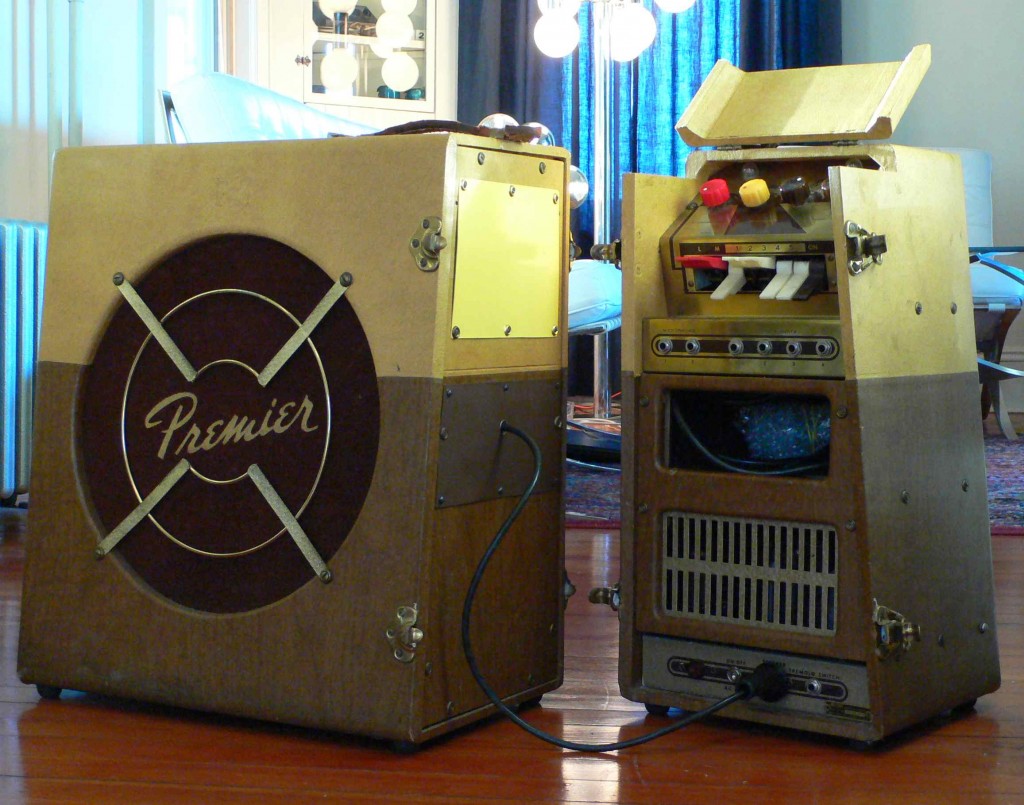 As I described in an earlier post, the Premier 88 is a rare and highly unusual instrument amplifier from the 1950s. It consists of an amplifier unit and a speaker unit; but rather than the amplifier unit sitting atop the speaker, like most every other 2-piece amp, the 88’s amplifier sits beside the speaker cabinet. The two sections clasp together with luggage latches. It moves as one (very large and heavy) piece.
As I described in an earlier post, the Premier 88 is a rare and highly unusual instrument amplifier from the 1950s. It consists of an amplifier unit and a speaker unit; but rather than the amplifier unit sitting atop the speaker, like most every other 2-piece amp, the 88’s amplifier sits beside the speaker cabinet. The two sections clasp together with luggage latches. It moves as one (very large and heavy) piece.
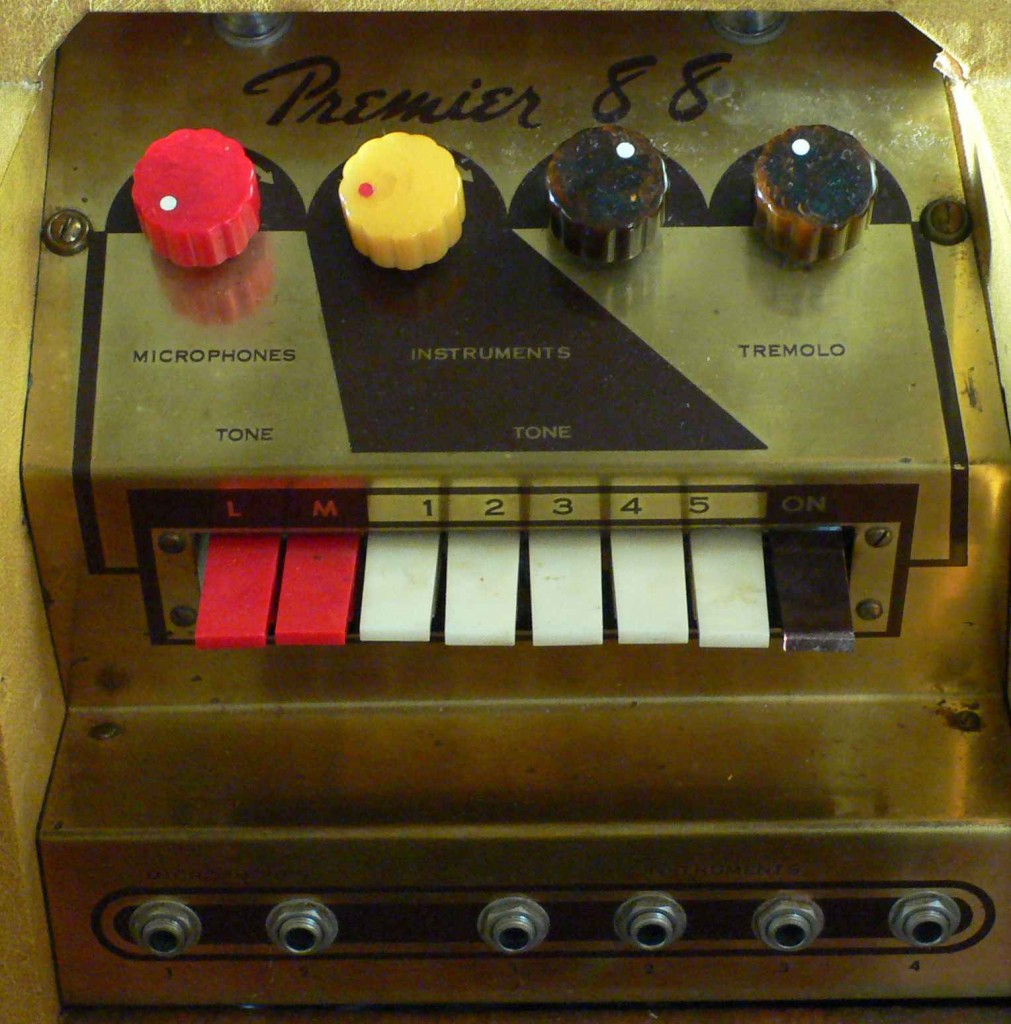 This odd side-by-side form-factor is not the only unique feature of the 88. Check out the control panel. Rather than conventional bass/middle/treble knobs, the ‘instrument’ channel of the 88 has 5 organ-stop-type levers that can be switched in or out. Each lever is a bandpass filter. IE., if you depress all 5 levers, you get the full tonal spectrum. If you depress none of the levers, you get silence. The ‘Microphone’ channel also has a pair of unusual tone control switches; they seem to be hi-cut filters.
This odd side-by-side form-factor is not the only unique feature of the 88. Check out the control panel. Rather than conventional bass/middle/treble knobs, the ‘instrument’ channel of the 88 has 5 organ-stop-type levers that can be switched in or out. Each lever is a bandpass filter. IE., if you depress all 5 levers, you get the full tonal spectrum. If you depress none of the levers, you get silence. The ‘Microphone’ channel also has a pair of unusual tone control switches; they seem to be hi-cut filters.
Here are some examples of the sounds that the 88 produces. Right channel is an SM-57 close to the speaker; Left channel is a 414 in omni approx 10 feet away.
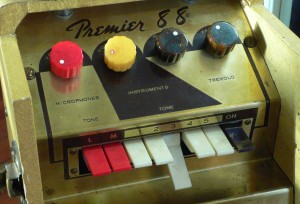 Listen: Mid_only
Listen: Mid_only
The trem is super weird and extreme. Here are a couple of examples:
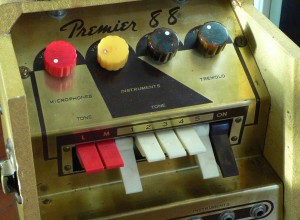 Listen: Trem_low_settings
Listen: Trem_low_settings
Listen: Trem_HighSpeed
***********
*******
*****
**
In all honesty, this amp was a pain in the ass to service. When I first brought it into the shop, it did turn on and pass signal; the tremolo sort-of worked, as did all of the tone controls. It just sounded terrible and it had no output. The longer it ran, though, more and more parts seemed to fail, starting with B+ resistors and then moving on to the 50 year-old tubes. So eventually I ended up replacing most of the components in the amplifier.
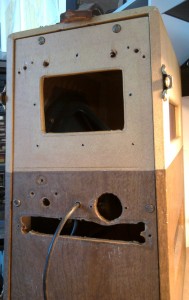
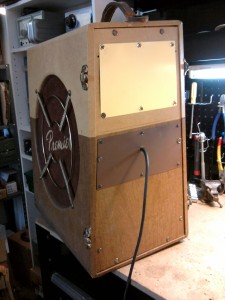 When I first opened it up, I saw tha someone had added a Pilotuner mono FM receiver to the speaker cabinet. I removed the tuner, and I then had to fabricate cover-plates for where the tuner face and tuner knobs had been. I used aluminum plate stock. That was the first piece of work. And then:
When I first opened it up, I saw tha someone had added a Pilotuner mono FM receiver to the speaker cabinet. I removed the tuner, and I then had to fabricate cover-plates for where the tuner face and tuner knobs had been. I used aluminum plate stock. That was the first piece of work. And then:
*replaced the 15″ Jensen Alnico speaker with a new Jensen 15″ ceramic (there was a weird rattle in original speaker)
*replaced all electrolytic capacitors in amp (approx. 20)
*replaced all B+ and plate-mixing resistors in upper preamp chassis (approx 15)
*replaced all caps in tremolo circuit (some needed to be replaced twice in order to get the right response)
*clean all tube sockets and replace 3x 12ax7 in pre-amp.
*add grounded AC line to power amp chassis
*replaced 6L6 and 5U4 and 12au7 tubes in power amp chassis
Good lord. Was it worth is? Who knows. Once you start a restoration like this, you kinda just need to push on through until it’s done done done. This is possibly the only working example of this amp in the world, so I felt like it deserved a chance.
The repair was difficult owing to 2 conditions:
*There is no schematic available for this particular iteration of the Premier 88, and the pre-amp is extremely complex owing to the bandpass filter arrangement.
*The amplifier is split into 2 sections: The top half is the pre-amp and trem circuit, and the bottom half is the phase inverter, power amp, and power supply. These two sections are joined by two cables: a shielded RCA line (audio signal) as well as an octal snake that carries B+, ground, heater lines, and tremolo defeat control. Owing to the extremely short length of these two cables and the manner in which they pass through the tight trapezoidal enclosure, the preamp cannot be operated unless the unit is fully assembled. So… the preamp circuit cannot be operated while its circuit is accessible.
Now that all is said and done, it is clear that I would have benefited from making an octal extender cable so that the preamp circuit could be accessible while active. Hindsight is of course 20/20.
A few things other repair tips that this repair has illustrated:
*If you are missing a schematic: don’t assume that the plate resistors for 12A_7s are 100k ohm. The 88 had 270k ohm plate resistors. Generally speaking, when i get an old, noisy amp, I just replace all the 100k resistors, assuming that these are the plate resistors. Bad carbon-comp plate resistors are often the source of weird intermittent noise in guitar amps. But not in this case! Premier used 270k ohm.
*Alnico speakers definitely sound better than ceramics for old guitar amps. I always suspected this, and now I am convinced. Wish I had sprung for the extra $100 for the Alnico Jensen.
*Don’t assume that working tubes can’t be causing weird intermittent problems. I am generally pretty trusting of working preamp and rectifier tubes, and I am often quick to assume that B+ resistors are bad, when i fact, it COULD also be the tube…
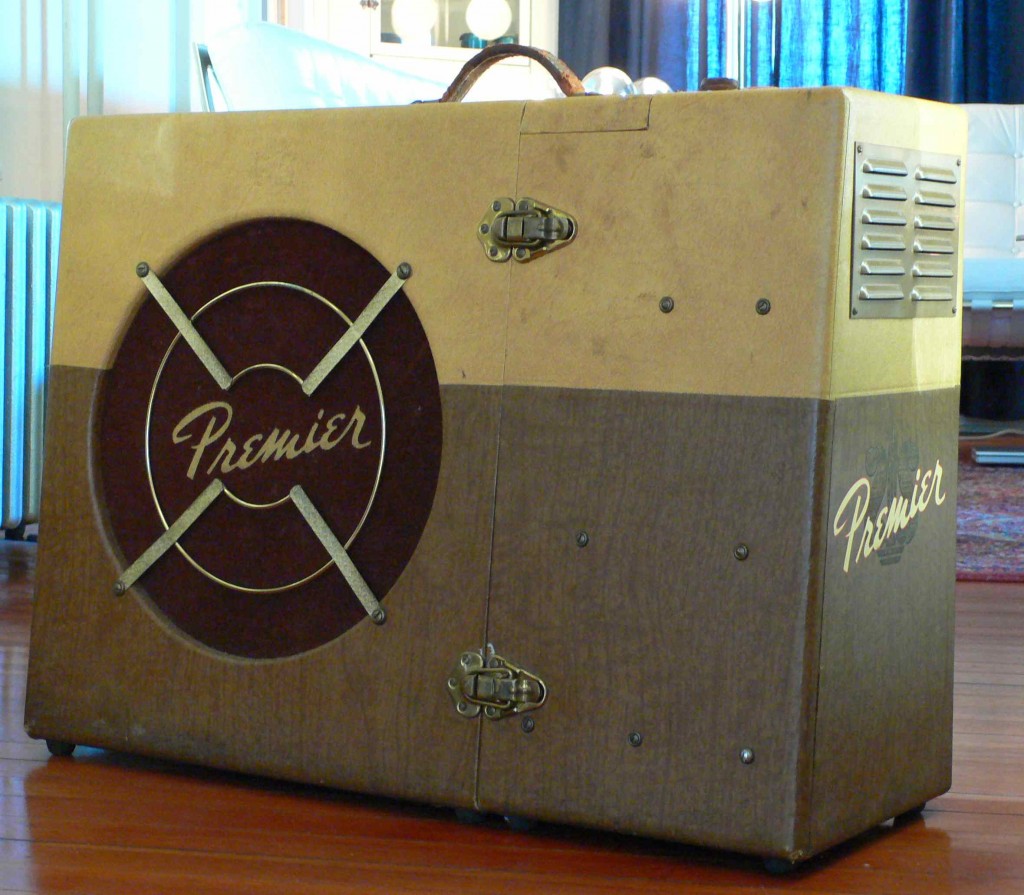
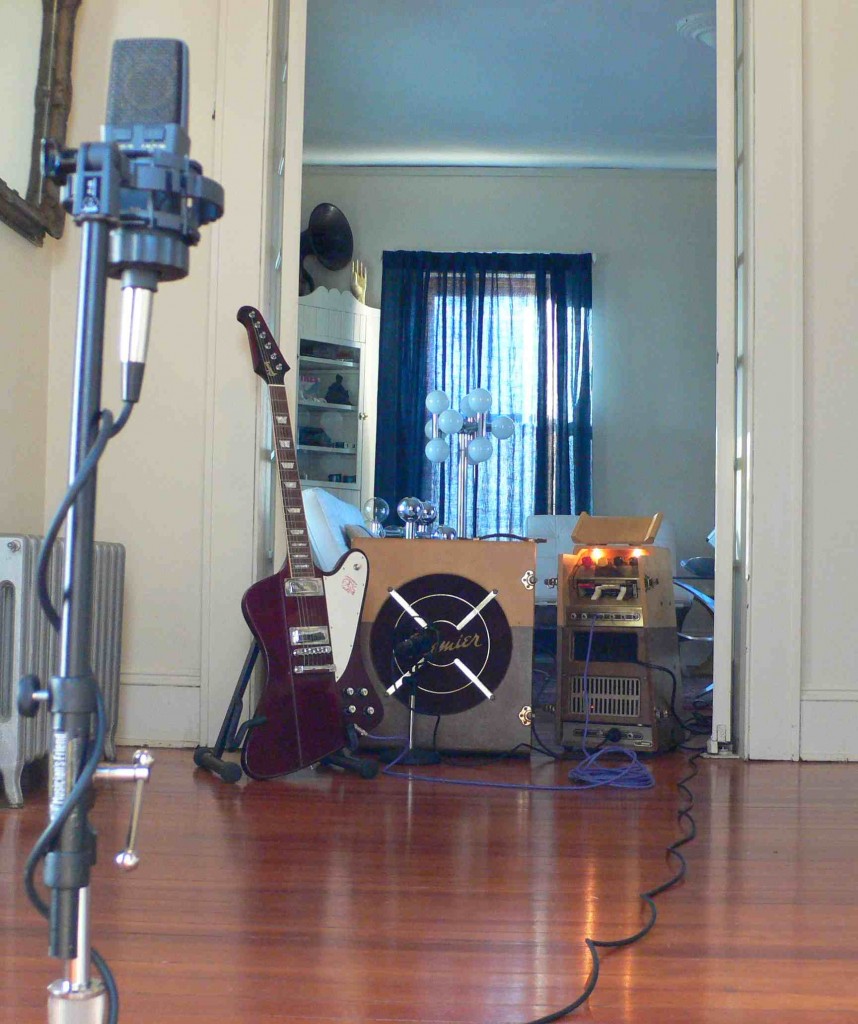
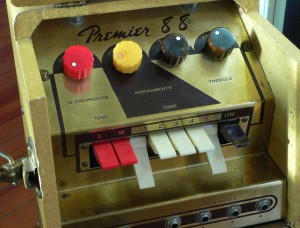
40 replies on “Premier 88: ready to go.”
I had one of these, it got stolen. Great tremelo. Link Wray used one of these to record “Rumble”. Had someone turn the trem depth control slowly up all the way through the recording till it was just a-poppin.
I’M GOING TO LOOK AT A 88N TOMORROW / LOS ANGELES
I WATCHED A FEW DEMONSTRATION VIDEOS – 2 GOOD…
HOW DID YOU LIKE THE 88N THAT YOU HAD – DID IT WORK PROPERLY. HOW’D IT SOUND ?
HEY, WAS THAT MIKE FROM THE CHARLATANS ?
CARLOS GUITARLOS HERE… I’LL CALL YOU TOMORROW
I am serviceing one of these amps now. Same 88 as yours. I wonder if you can provide me with the tube layout for the preamp section. Customer brought it in with them all pulled.
Thanks, Andrew
Hi Andrew. Damn i can’t recall. you should be able to figure it out by checking out the biasing resistors on the cathodes. From what i recall, the 9-pins were all 12AX7s except for one, which was 12AT7 or 12AU7. The 7-pin is i believe the trem LFO driver and I think that was a 6AU6 or 6AV6? one of those i think… I could never find a schem for this unit and mine is long gone (sold) so can’t help ya anymore. but i think it will work just fine with 12AX7s in all the nine-pin slots… for the other one.. yeah you should be able to figure it out from the resistors. good luck.
I came across this site while searching for information on the Premier 88N that I was restoring. I bought it years ago because it looked cool, and I liked the Catalin knobs and switch paddles. I never imagined that it would be the nightmare to get working that it turned out to be.
The one I have is earlier, 1951 vintage from the date code on the 12 inch Jensen field coil speaker. It uses a quad of 6V6s, two 5Y3s and three each 12AX7 and 12AU7 types.
The first big problem I encountered was the field coil on the speaker was open. It turns out it was 10K ohms. Speakers of that type are around, but never with that field coil resistance, I managed to get one from a Hammond organ with a 700 ohm field at a reasonable price. I ended up building a field supply into the speaker cabinet to run it. Putting it into the B+ path ate up too much voltage and cut the output from about 20 down to about 15 watts.
The filaments on the preamp and phase inverter tubes are in series, and form the cathode bias resistor for the output tubes. As it is, they are only running about 9 volts each, and the 6V6’s are being hammered to get that much current through them.
One goal was to draw up a proper schematic for this amp. What I found was that about 20% of all the resistors had NO color codes on them at all, or the actual codes were painted over. One had actually been ground down to change the value. They used a strange assortment of resistors that would appear to have been leftovers from the 1930s that they probably bought cheap. The painted over ones were apparently mis-marked factory rejects.
I found sloppy workmanship throughout. One joint was never soldered, and the switch assembly was improperly mounted so when you flipped the switch levers down they hit the metal panel, and really didn’t go down far enough to make reliable contact.
The wiring is a true rat’s nest, and the passive components are all on terminal boards, up to 6 inches away from the tubes they connect to. The output transformer is an old replacement that was larger than the original and didn’t fit right. The replacement was right up against one of the 5Y3 tubes, and the paper covering was a bit charred (I rewired it to use a single 5U4GB to keep heat away from the transformer. The two transformers are nearly touching each other, and there is magnetic hum coupling between them.
I had to play around with the phase inverter, tremolo, and tone control circuits to get them to work properly (and to keep it from oscillating). I replaced every capacitor, most of the resistors, and all of the tubes (they were all originals). At least the cabinet was in good shape.
As a final insult, I found that the panel marking on the tremolo switch was backwards, when the switch was “on”, the marking said “off”. The outer trim panel which hides the tubes also hid the markings on the power switch.
Chris, if you got through yours with only a 14 hour investment, you were lucky. I must have spent 2 or 3 times that on this beast!
If anyone wants a scan of my schematic, feel free to email me through my website.
Hi mike. Yea this one was a drag and a money loser even though it only cost me $120. Well time waster at least. I think it sold for $450. To the rest of y’all: Mike’s comment brings up a few good points. First, there are two types of field coils. Low resistance (500 ohms for example) is a b+ dropping coil. This is best substituted for with a choke of similar resistance and enough current capacity to handle all of the output tubes in the amp. 5 henries is more than enough inducatnce. On the other hand, A high-resistance coil like mike encountered is a b+ bleeder: it simply runs from the B+ to ground, much like some manufacturers used ‘bleeder resistors’ in power supplies so that operation would cease quickly as soon as the mains are disconnected. You can replace these type of coils with a decent wattage wire wound resistor of the same resistance and then use a regular pm speaker. 2nd point: always beware power trans adjacent to output trans. Although it can be done properly is usually causes hum.
I should have mentioned, your original post gave me inspiration to keep going on this project, there were certainly times when I wanted to cut my losses and give up on the damn thing. Thanks!
hi. i’ve got one as well. 88n. it’s a nitemare>my amp tech is trying to figure it out as well. i picked it up 2 weeks ago. already he’s found a lot of the same craziness that you described. i would love a copy of your schematic> would be forever grateful.>how much did you want for it?> 716-826-1349 >>> joe
I am the tech at Alpha Music in Virginia Beach. One of my customers brought me a Premier 88N and a schematic. If you would like a copy of the schematic e-mail me back and I will send it over.
You are right about this amp being a nightmare. This guy brings me vintage amps and this will be the first time I cannot help him. Too bad because after he dropped it off he went and had a new box built for it.
Tom McCraig
757-486-2001
hi Tom. YES if you have the schem for the version of this amp with 2x 6L6 and the bandpass filters in the preamp, PLEASE SEND IT OVER! it is not avail on the ‘net currently. c.
I was hoping to get a schematic for the Premier 88?? I read your offer on the website and thought it would help me with mine….
Thank you
Dennis
hi Tom, I’m Robert, an amp tech in L.A. San Gabriel Valley, and have this Premier 88N back to me for service after 20 years and could really use the schematic for this four 6V6/dual 5Y3GT rectifier model.
Called today and was told you’d be in during the week but not on weekends. After looking over my work and damage incurred since my last service, I realize my novice mistake was to not replace all 400V and 450V caps with correct value caps in 500V ratings. Oh well. This time I’ll get it right but of course in the interim, the client kept upping the fuse value after repeated blown fuses resulting in extreme lacquer leakage. More work and crossed fingers that the power tranny is not completely fried… doesn’t smell burnt to me. Will call this week and I’m thanking you in advance for any help with this matter. Best regards, Rob the Amp Man
Hi Tom,
I am currently working on a premier 88N. Would it be possible to email me a copy of the schematic?
Regards, Rich
richmvv@yahoo.com
Hi Mike,
I have a Premier 88N that I am restoring. Needless to say it’s in bad shape. The unit I have has the (2) 5Y3’s and the 6V6 quad output tubes.
If you could email me the schematics it would be a big help.
best regards, Rich email: richmvv@yahoo.com
Just came across this article and I’m having the same nightmare
Do you have the schematic for this premier 88N?
I really appreciate if you do cause I can’t find the schematic for this model anywhere! I can find for the 88 but it for the 88N
Thank you
check the earlier editions of Aspen Pittmans ‘the tube amp book;’ IIRC it may be in there. good luck.
I saw another Premier amp decades ago and simply walked away after one look at the chassis. Fender and Marshall dominate guitar amps for a reason: they built them right, the parts are on tag boards, etc.
i picked up an 88 in the 60’s.
i don’t remember mine being like yours.
been searching for what i had, but no luck.
my amp split on the diagonal, into 2 even sized parts. (head and speaker)
wish i still had it.
I own 88 for over 3 decates not sure the exact year manufactured and still near mint condition. Does not look anything the one you have in studio is split on diagonal as Gary above said. Sounds good but at some point I have to rely for a reputable tech. Anyone have any suggestion. The only thing so far the original power cord just start craking at the near of the male plug and the reason is after each time I use I have to shavel in the storage opening with the speaker wire. I rarely use this amp. Looks like a early linclon dashboard with the (2) right and left side pilot lights hidding over the instrument panel and push buttons that illuminates.
Thanks
This is such a cool looking amp and yet an absolute abortion electronically and constructionally. Someone ought to make a cosmetic replica with better design and layout.
I have one of these I got from my Dad. Everything works, but he told a story that in the 60’s he rewired it and replaced the Jensen speaker. I have played it some. Sounds really cool actually. It now SHOCKS me all the time…and I need original hardware as the pieces don’t clasp together. He recovered it back then, and it no longer has the hardware.
Totally cool living room piece.
If anyone has one to “part out” I would be interested….
The hardware is probably common stuff used in cheap luggage and tool boxes of the day. There are sources but I don’t know of any: kids still get the stuff for junior high shop projects, so asking a shop teacher might be the thing to do.
If it’s shocking you make sure the ground wire is grounded and the hot and neutral are fully floating. If there are “death caps” dike them out.
This is an excellent discussion. Of the 3000 plus amplifiers I have repaired, this is the only 88N that has come through my shop. Considering the comments here, it makes working on the Gibson Super 400 a walk in the park. It does work, doesn’t have a whole lot of character to the sound either but it’s a start. The tremolo isn’t working and it produces maybe 10 watts right now. One thing I noticed is that it has all new 12AU7’s and not a single AX7. So my question is, looking from left to right on the preamp, what is the tube lineup? In my mind, the first 3 would be 12AX7 followed by the 12AU7 for the tremolo oscillator. Is this correct?
Thanks in advance.
Billy Yates
Hi Billy. I can’t recall which was which. At the end of the day, it was the 10m (yup) trem pot that was at fault with the the trem. This thing cost a fortune to fix. c.
Chris
Thank you. Seeing how the work load in my shop is time sensitive, I informed the client I was not going to restore it and while someone had attempted to do some recapping, I realize the gains made by repair isn’t going to be realized for both the client and myself. This amplifier is among the worst designed I have ever seen and while I could gut it and make it right as rain, I wouldn’t want to hand the client a bill for 100’s of dollars. A rats nest is an understatement! I am amazed it works at all and isn’t one giant oscillator. Back together it goes and hopefully I persuaded him to place it up for sale. It belongs in a static display somewhere.
Again, what a great discussion thread you have here and thank you for the hospitality.
Billy Yates
BTW…
The plate load resistors in this specimen are 330K.
I have this exact amp and played it off and on for over 20 yrs. Chris Davis “amp wizard” (worked with Frampton, Hall & Oates,etc,) has kept it up and running for yrs. This amp truly wails! I play mostly strats and thinline teles, but with the unigue tone structure this thing can handle anything, The 15 spkr sounds great and the tremolo is sick. Ibe happy to compare notes with anyone. Thanks.
Hi, mines a 1959. I got it in 66, still use it. It had a 15 and two tweeter, two 6l6. replaced caps and tubes over the years, the cabinet fell apart so I built a new one in 70. The schematic is in Aspen Pittmans tube amp book 4th edition page 736 737. The amp has a full rich tone, and the trem sucks. 45 years and it nevers lets me down. Good luck and good tone to all. Jerry
I just finished restoring a ’58 Premier 88 with the P15N and pair of tweeters. Had to replace many parts including all the coupling caps, speakers, both filter cap cans, etc., and it now sounds great. The amp cab is missing the vented shelf that fits over the chassis. If anyone can share pics of an original and/or what this shelf was made of, dimensions, and how it was mounted, any info would be much appreciated.
I found material for the shelf that fits in the opening over the chassis in the amp section at Reliablehardware.com under “custom speaker grills”. The dimensions of the shelf in my amp are 9″ wide by 7&3/8″ deep. Pics of original material in a couple of amps I saw on-line are squares (in an older model) and 1″ x 1/8″ oblong ports in the same model as mine. I had to make 2 new wood brackets that the shelf rests on, and used the original holes in the sides of the cabinet to mount the brackets in the same location as the original.
Any buddy know anything about premier surper 88, what types of tubes they used.
the super 88 has 2 * 6550 output tubes. around 45 – 50 W. i have two super 88 amps and it is my favorite harp amp. no feedback and power for a hall with 300 people. I have several premier amps 110, 160, 71, 220, 88N und super 88. the premier reveration is also a god tool. reduce feedback and make a warm sounding. Greetings from bavaria Edi
if you see a super 88, take it. I´m looking 12 years an Ebay and I had saw 3 peaces and buyed two. It is a high class amp. The best of all premier amps. Much better as a 88N (4* 6v6) and better as a 220 or 71 (2 * 6l6). Much better as a sunnytone (4 * 6l6). Much better as a Fender bassman reissue. Much better as a Gibson GA90. I have many amps and this is the holy gray.
I found a Premier 88 at an estate sale. Its been sitting in a closet for 38 years… Near show floor condition.. It all works and sounds sweet! Score!!
How much did it cost?
I just saw Tobin Sprout at the El Club in Detroit this past Thursday. He had two of these on stage that he and another guitarist were playing through. It’s the first I’d ever seen of them. I thought they sounded great. Tobin played a Tele through it. Anyhow, just trying to learn more about them and came across this.
I recently acquired a 1959 Premier Md. Super 88…2 x 6550’s. does anyone have a schematic fro the preamp? The power amp schematic is available at El-34 World, but I don’t find the preamp schematic anywhere.
Update…..I got this amp back into operation without a true schematic….replaced all electrolytics and all of the paper-in-oil tone and coupling caps. Fantastic amp…very versatile.
I’m researching Premier amps in the hope that I can get a replica made. I’m in the U.K. so they’re as rare as a frog feather! This will be for a Link Wray tribute band and we’re aiming for ‘that sound’. There doesn’t appear to be a schematic anywhere for the model 71 so I’m wondering what model would be in a similar ball park?
Plus, what kinda power rating? I think the model 50 is around 7watts. I’d need to keep up with a drummer so I’m looking for something around 25w. I understand that watts aren’t volume, just need a bit of power though
Vince, I have no idea if this will reach you, but My Md. Super 88 does the ‘’Rumble’ sound exactly with only the high frequency tone tab selected…and the tremolo, of course.
If you get this and want to correspond all of these years later, let me know.